Melbourne is currently in the middle of the changeover to digital television, with the original analogue system to be turned off in December 2013, leaving millions of older televisions with cathode ray tubes on the scrapheap. So how to get rid of them?
In my local suburb the annual hard rubbish collection is approaching, so many of my neighbours have emptied out their spare rooms and put their old televisions out on the nature strip for collection. My 1.2 kilometre long walk to the railway station passes around 150 households: so how many televisions can I find?
Televisions 1 and 2: a pair of 10 year old mid-sized CRTs.
Television 3: a cheap Teac telly.
Not quite a TV: someone has dumped their old CRT computer monitor for a new LCD panel.
Televisions 4 and 5: another pair of 10 year old mid-sized CRTs.
Television 6: someone’s tiny bedroom TV.
Television 7: another 10 year old mid-sized CRT.
Television 8: something a bit different, a 30 year old small Sanyo portable with a VHF-only push-button tuner.
Televisions 9 and 10: two more 10 year old mid-sized CRTs.
Televisions 11 and 12: and two more mid-sized televisions.
Televisions 13 and 14: two different TVs, a 1980s midsized unit, and an oldschool wooden floorstanding cabinet set.
Television 15: another nice unit, this time an AWA portable unit with rabbit ears and a VHF-only turret tuner – do you remember the mysterious channel 5A?
Television 16: a pretty big Sony Triniton.
Televisions 17 and 18: more 10 year old mid-sized tellys.
Televisions 19 and 20: still more of the same.
Television 21: another small bedroom television.
Television 22: another mid-sized television, perhaps from the kitchen?
Not quite a TV: but an old box for a 68 centimetres CRT telly.
Television 23: yet another mid-sized television.
Television 24: a cheap-arse Conia.
And just outside the railway station… a box for a digital PVR that someone bought to use with an existing television.
In less than 15 minutes I found 24 old televisions by walking passing around 150 households – one in six is throwing out an old TV. Over 100,000 tonnes of old televisions and computers (16.8 million units) were disposed of across Australia in 2007-08, but 84 per cent (by weight) went straight to the trip, despite containing hazardous materials such as lead, cadmium and mercury.
I’m sure Harvey Norman and the credit card companies are loving all of the new televisions being sold in Australia, but I hate to think of the hazardous materials ending up in landfills.
Further reading
- Recycling Near You: find a recycling centre to take your old junk
- National Television and Computer Product Stewardship Scheme: an upcoming Federal Government scheme to to address the issue
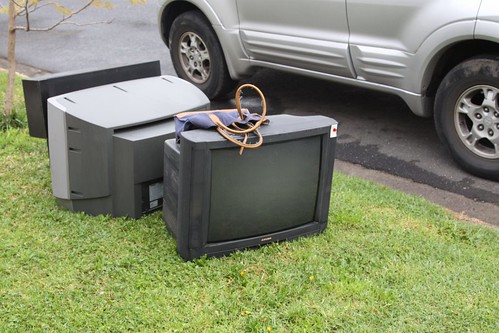
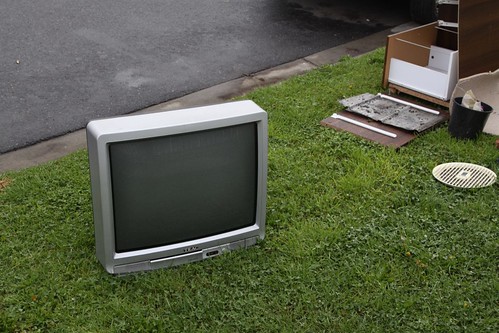
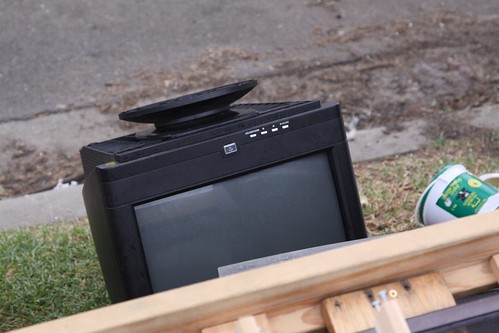
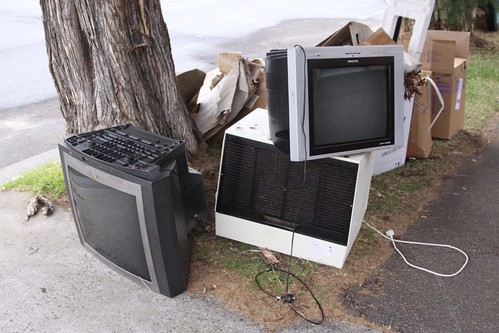
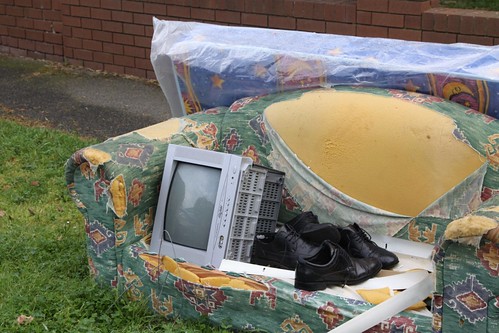
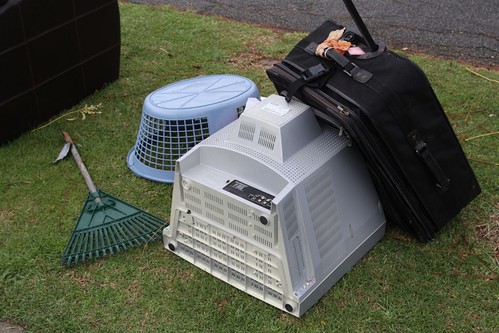
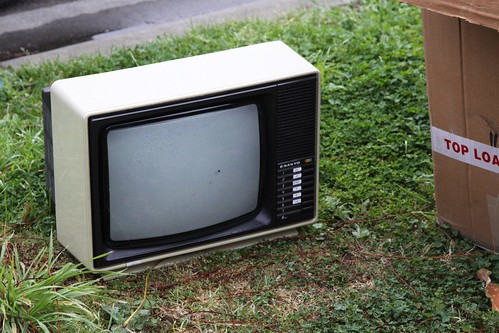
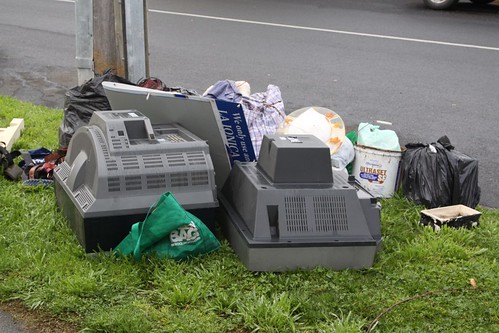
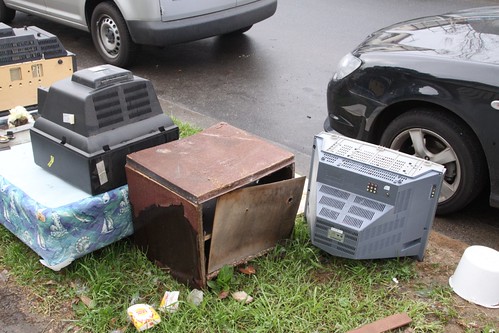


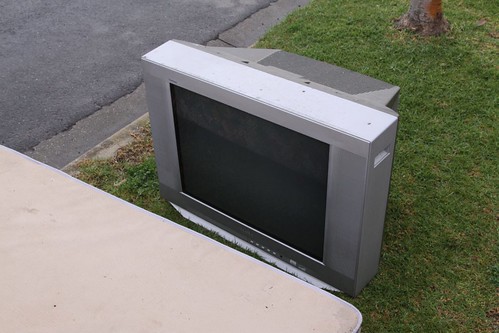
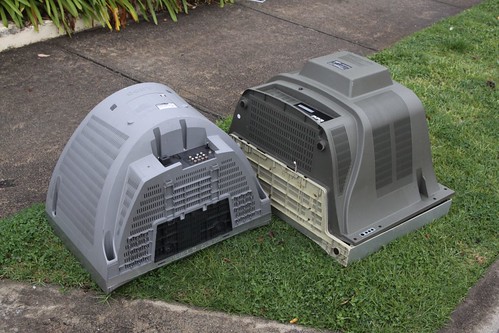
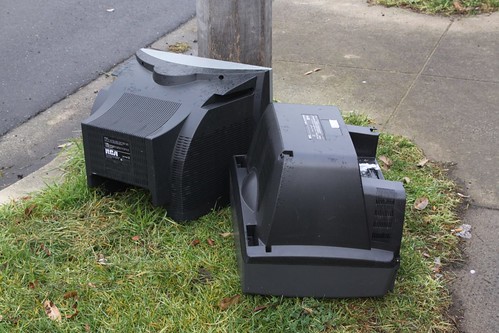
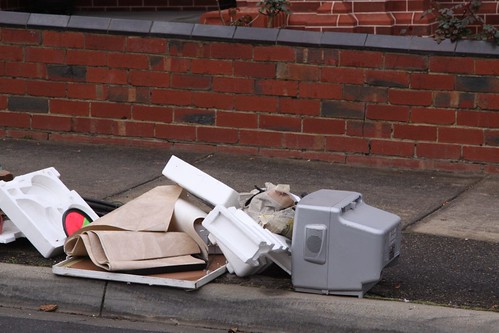
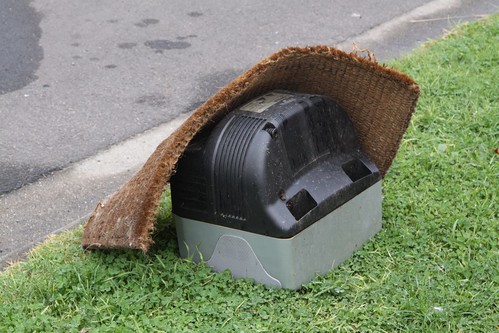

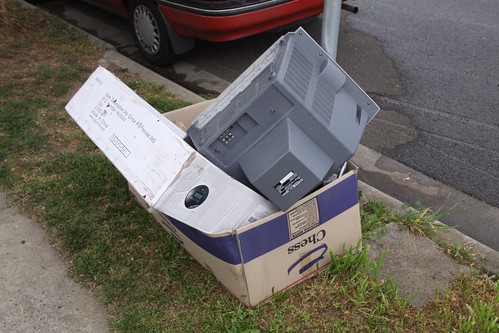
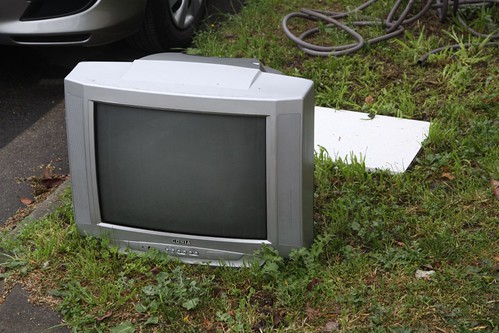
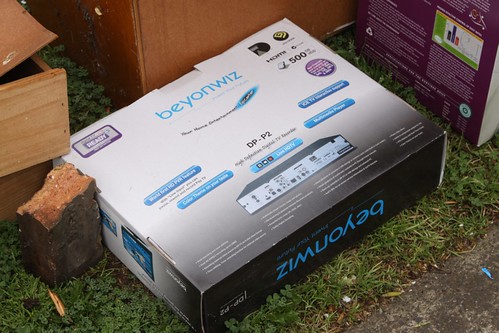

Yes, it does seem like quite a waste.
Actually, for channels 0-12 (including the mysterious 5A) you mean VHF, not UHF.
Thanks for that correction Boyd: I used to have a dual VHF/UHF telly with a pair of turret tuners, so I must’ve gotten the two bands mixed up.
[…] Last week on my way to work I discovered dozens of obsolete CRT televisions placed out for the hard rubbish collection – this week I walk past and a half dozen of said televisions have had their screens shattered […]
Boy, that’d be my idea of heaven!
I pull the circuit boards out of old CRTs, and re-use the electrical components for other electronics projects. I also preferf using a CRT television set to a HD LCD or plasma set. Gotta be careful though. Larger CRTs can have up to 10 tonnes of air pressure pressing in on the tube, so implosions can be spectacular! Also, just a fun fact, CRTs can have up to 26,000 volts in the tube (between 0.005 and 0.010 micro farads), and unless the set has a bleeder resistor connected to the anode, they can still hold 26kv after being grounded. You have to keep them grounded, because the voltage is so deeply buried in the glass.
Chris
Scavenging components of out old electronics reminders me of my younger days when I didn’t have enough money to buy them new from Dick Smith!
The vacuum pressure and residual voltages sounds dangerous: at least with beefy capacitors you can discharge them by putting a resistor across them.
Money’s not too much of an issue (though I do try to save every dollar I can), but it’s fun salvaging PCBs and removing the components from them. I’m still trying to find a project for all these components. Especially for all the HV Flyback transformers that seem to breed in here…
Cathode Ray Tubes really are not something to mess with, unless you have enough knowledge of how they work and the associated dangers. Actually, a CRT can store up to 32,000 volts, not 26kv as I said in my last comment. Luckily for those of us who like to go poking and prodding around inside television sets, some newer CRTs have a bleeder resistor built in (Connected to the anode via the flyback transformer I think…), to dissipate the charge in a CRT after its been unplugged from the mains.
With higher voltage/micro farad electrolytic capacitors, I generally just touch the two terminals with a screwdriver. There are some nice sparks (especially on a slightly rusty screwdriver), though the cap leads sometimes partially weld themselves to the screwdriver. It’s recommended to use a resistor to avoid the sudden jolt of energy,as this may damage the cap. I can’t imagine there being any resitors beefy enough to handle the voltage inside the CRT, though I do remember reading about resistors being used to safely ground these too.
I’ve gotta say, it always amazes me to see CRTs with the screens shattered. Considering how thick the faceplate is, I have to wonder… I hope thugs aren’t carrying sledge hammers around with them these days. I wonder how many of them sh*t their trousers after the loud *pop* the imploding CRT makes when they smash the faceplate…
[…] A decade ago the changeover to digital TV in Australia was well underway, so during hard rubbish season old-fashioned CRT screen TVs lined the streets. […]